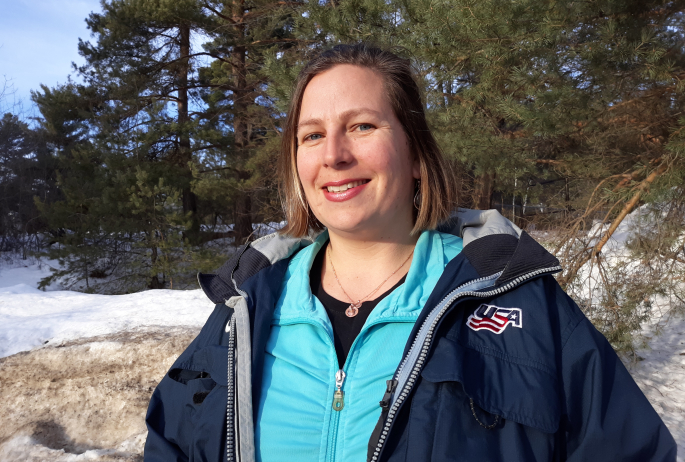Andrea Kilbourne-Hill was born and raised in Saranac Lake, and is now doing the same with her own family. But between those bookends, Kilbourne-Hill has earned a degree from Princeton and a silver medal in Olympic women’s hockey. And while that may seem like a lot for a small-town kid, she is really just getting started.

Kilbourne-Hill is now back in her hometown, teaching fourth grade. She said her decision to come back to the Adirondacks was driven by not only her love of the place, but also by a curiosity of what it’s like to raise a family here.
“After college, I moved to Boston because I was still training with the National Team and that’s where a lot of our team was,” she said during a recent interview. “I knew I could get a lot of ice there and people to skate with. And then every time I would come home, I would drive through the Cascades (Cascade Pass, outside of Lake Placid) and be like, ‘Why am I going back to the city and to traffic?’
“I love Boston as a city, but I got to the point where I was like ‘Why am I doing this?’ Especially when I was done training - I knew that there wasn’t really anything keeping me there and that’s when I decided I was going to come back to the Adirondacks, come back home, and see if this was where I wanted to stay. Because I was training so much I never really got to live here as a young adult, and I wanted to try that so I decided to stay.”
Kilbourne-Hill graduated from Princeton after taking a year off to train for the 2002 Salt Lake City Winter Olympics, but said she faced both problems and had support as a young female athlete - especially growing up in the shadow of one of the most famous moments in sports history, the 1980 Miracle On Ice, when the US men’s hockey team defeated the Russians in Lake Placid.
“I think when I was growing up, it was a different world,” she said. “I’m not that old, but even 20 years ago it was a different world for female athletes. I think one piece was, ‘Where do I go with this?’ So you had to really have that vision in your head on your own. Another obstacle was equity in general. I got dressed in the bathroom, my dad made a stool for me so that I could sit and tie my skates because I was the only girl on the boys team. They would get a locker room, but now you go to rinks and there’s a female locker room sometimes. It’s totally normal now but the equity wasn’t as important to have, to treat boys and girls equally when I was a kid.
“The other big thing was that growing up, I was kind of the anomaly that wanted to make it to the next level, which was tricky because my friends would be having sleepovers or going away for spring break, and I would be here staying home training,” Kilbourne-Hill continued. “So the culture of being an elite athlete as a girl wasn’t there. Girls wanted to compete in high school and they worked hard. If you look even at Saranac Lake High School you have a lot of girls that are really good Nordic skiers or trying to get to that next level (and) I didn’t have that so much.
“I was 14 I think when they announced that women’s hockey would be an Olympic sport, and I put Olympic rings on my mirror and that was the goal. It was nice that there was something to shoot for. I think growing up here where the Olympics aren’t something that just happens every four years was important. I mean, you drive through Lake Placid and it’s Olympics all the time.”
Kilbourne-Hill followed that Olympic lead all the way to the 2002 Winter Games in Salt Lake City, where the US won the silver medal by obliterating Germany (10-0), China (12-1), and Finland (5-0) in the opening rounds. The team then went on to beat Sweden 4-0 in the semifinals before Canada topped the US in the gold medal game by a tight score of 3-2. But Kilbourne-Hill isn’t done with hockey, particularly in the North Country.
In 2017, Kilbourne-Hill was tapped to create - from scratch - a women’s hockey program at Paul Smith’s College, the only four-year college within the Adirondack Blue Line. The small school - which specializes in natural sciences, hospitality, and culinary arts - was looking for ways to increase the number of female students on campus, and Kilbourne-Hill’s hockey program was one part of that effort.
Kilbourne-Hill said female hockey players who aren’t recruited to top colleges often have nowhere to play after high school, and she hopes the Paul Smith’s team offers a place for local women to continue skating. The Paul Smith’s women’s team is now up and running, even earning a mention in a recent article in the Washington Post.
“They had a full season this year, which is great,” Kilbourne-Hill said. “The girls seem happy with it and I think it has added to the school culture, which is one of the things we were really hoping for.
“I think for the athletes, it’s a nice spot. For anyone who’s a local or a North Country kid who’s been playing hockey their whole life and all of a sudden has nowhere to play because they’re not quite good enough to go play Division III, it’s a really nice fit because they still get to play hockey and study. For the women, it’s nice to be able to have that piece that they can still do. It’s part of your life, part of your identity. And for the school, it’s nice to have more programs that bring in strong females.”
--
Read more about other inspirational Adirondack women...
Inez Milholland: Forward out of Darkness
Cheri Cross: Crafted by hand, with love
Great Camps, greater women
Hiking with Grace Hudowalski
Nina Lussi: Taking flight
Amy Farrell: An ADK badass


